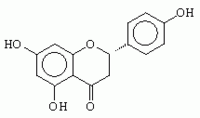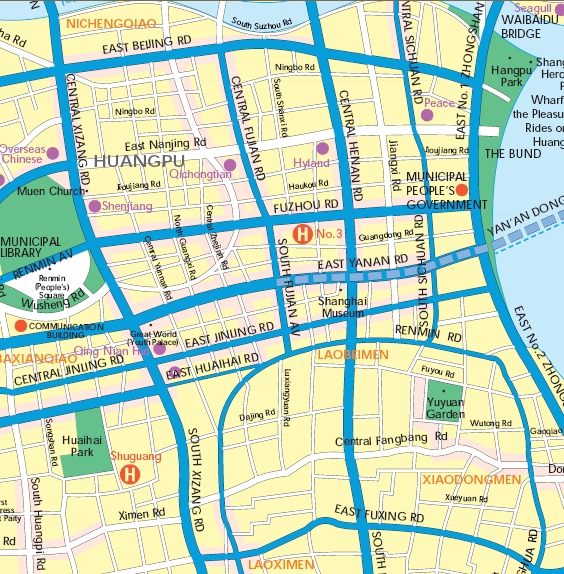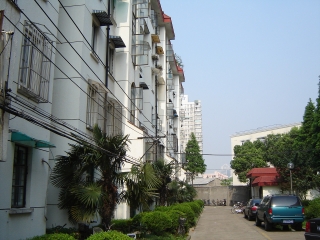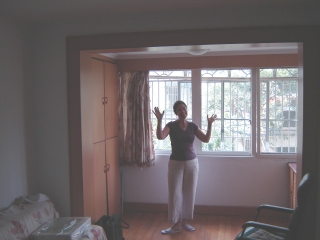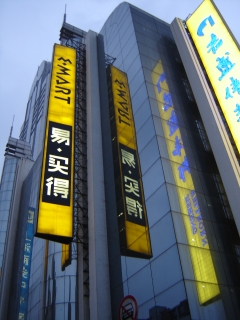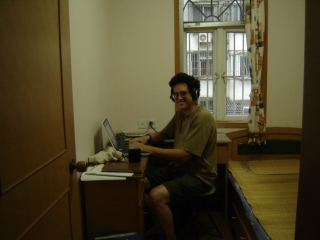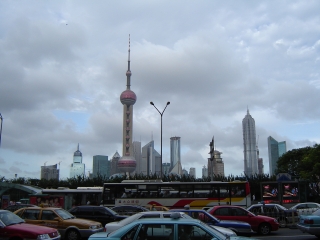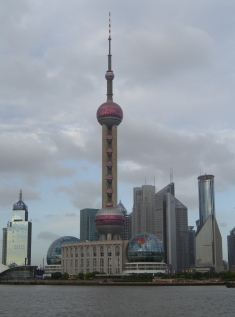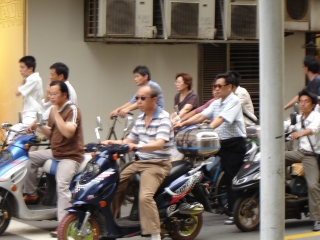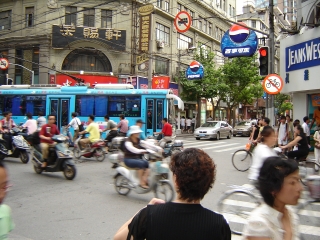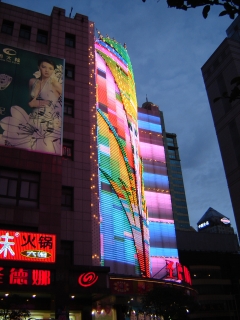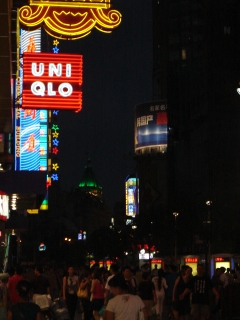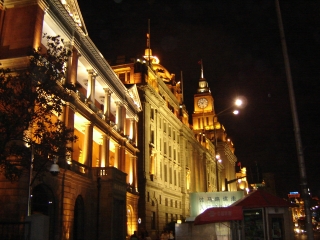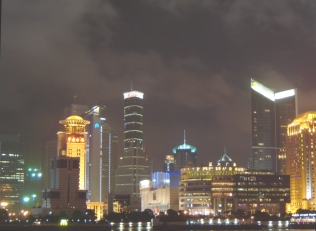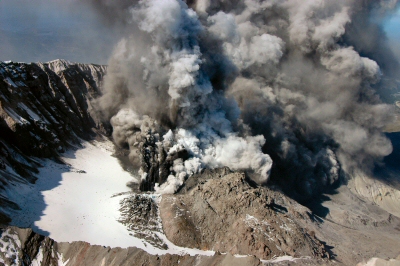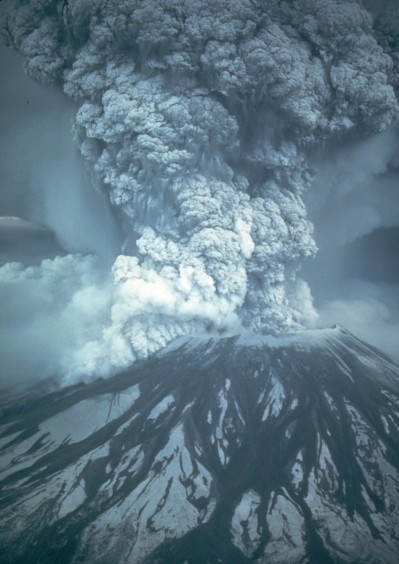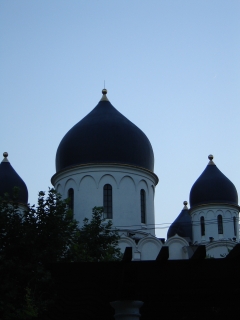Diary - July 2006
John Baez
July 2, 2006
A transitional day: packing and cleaning up around the house before
taking off for China tomorrow. I wanted to sleep in late, but I had
to trim the bushes that were overwhelming the sidewalk in front of the
house before it got too hot. It's another scorcher, after a week of
scorchers, headed for 104° Fahrenheit (or 40 Celsius).
A garden is an ever-changing thing, even if you put a lot of work
into keeping it the same, which Lisa and I don't. The soil here is
good and there's endless sun, so plants grow like crazy if you just
water them. Of course, introducing non-native species
and watering the arid land here is an innately
out-of-balance activity — an indulgence. All I can say is that
removing the lawn and replacing it with citrus trees and Mediterranean-style
vegetation has cut the water bill down to half what it was — or a
third in summer.
And, next year we may not need to buy as much
fruit! We'll have blood oranges, and Meyer lemons, and kumquats,
and probably something else I'm forgetting. No
grapefruit, which is
a pity, since I've gotten to enjoy a grapefruit for breakfast every
day. There's something marvelously healthful-tasting about grapefruits
- I can't get enough of them, in part because I was allergic to
citrus fruit as a kid, and there's nothing like the lure of forbidden fruit!
But in fact, they're just
good: not only good-tasting, not only
good for their vitamin C, but also packed with other nice
compounds. I don't need to know what these are to like how they
taste and feel better after I eat them, but what the heck, let me
list some!
-
Lycopene:
this is a red chemical especially present in
tomatoes, but also in ruby grapefruit:
It's a carotenoid,
an organic pigment made of a long chain of carbons connected by double
bonds. The chain allows the atom to absorb photons and send electrons
into excited states where they're delocalized — spread over the whole
chain. The longer the chain, the lower energy these excited states
have, so the redder the molecule is. The β-carotene in carrots is
orange:
while lycopene, being longer, is red. All these carotenoids are great
antioxidants — they react with a nasty oxygen radicals. Animals
can't synthesize carotenoids, so they have to eat them — that's how flamingos,
salmon and lobster stay pink! Having bright plumage is a sign
of being "in the pink of health" for many birds, so it
plays a role in sexual selection:
a pale flamingo
is an unhealthy flamingo, and will not get much attention from potential
mates.
(Do healthy flamingos eat carrots? No, they eat things like
shrimp which in turn eat somebody who can synthesize carotenoids.
Algae can do it — they can even make the
snow pink!)
-
Limonoids
like limonin, nomilin and nomilinic acid. These give citrus peels
their nice tangy scent. They have antiviral, antifungal,
antibacterial and insecticidal properties which defend the fruit
against pests — following the same basic principle that
underlies the nice smell of pine needles and many herbs and spices.
Indeed, the chemicals that give pine needles, cinnamon, cloves,
ginger, camphor and mints their smell are terpenes and terpenoids - and the
latter include the limonoids.
It's fascinating to me that these
chemicals, which prevent pests from eating citrus fruits and
spice, make us want to eat them.. and that we can benefit from
their properties! So, we cultivate them and breed new varieties.
It's as if these plants and we are in the same side in
the bio-battle against insects and microorganisms.
Of course, there also plants we should beware of, like sassafras — it
smells great, and I used to make tea out of it as a kid, but the
nice-smelling stuff, safrole, turns out to be a
mild carcinogen! So, we have pick our allies wisely.
-
Naringin. This
is what makes grapefruit bitter:
I really love this stuff — it makes me feel healthier, especially
when I'm on the brink of a cold.
How does it work? The sugary stuff on the left gets removed as
we metabolize it, leaving
naringenin:
which is a flavonoid.
Like many flavonoids it's an antioxidant and free radical scavenger.
It also has anti-inflammatory properties, boosts the immune system,
and can even repair DNA!
-
Hesperidin
is similar to naringin:
but you find in oranges and lemons rather than grapefruit.
As with naringin, our body rips off the sugar groups, leaving
a flavonoid:
called hesperitin.
Clearly hesperidin and hesperetin are named after
the Hesperides,
those western isles of Greek legend where the golden apples of immortality
grew.
Golden apples of immortality? Sounds like a myth
about the health benefits of oranges! In fact, some people locate
the mythical garden of the Hesperides near
Tangier, whose name we find in the word "tangerine".
So, you shouldn't be surprised that there's yet another flavonoid
called tangeritin.
This reminds me of how there was no English word for the color
orange until the fruit made its way up there after the Moors
carried it
from northern Africa to Spain. Flavonoids not only
keep us healthy, they make the world more colorful!
Hmm, I'm getting carried away.
I've got to finish packing. But first, I'll grab myself
a grapefruit at the supermarket!
July 3, 2006
Woke up grumpily at 6 am to catch a shuttle to Los
Angeles International Airport at 7 am, arriving around
9 am for a 12:30 flight to Tokyo Narita Airport. Read
and slept as much as possible; utterly no desire to
think about math, oddly. Too much focused on the adventures
to come. A front-row seat let
me stretch my legs, so nowhere near the hell it could be.
July 4, 2006
Arrived in Tokyo 3:30 pm the next day, thanks to the
magic of the International Date Line. Beautiful
overview of Japan as we sailed low over the sandy coast,
then rice fields and complex canal formations, then houses
and golf courses. Many buildings in this part of Japan
have blue roofs. Why?
My 6:30 pm flight to Shanghai was delayed to 7:10 — the
only glitch in this tedium of transport. I arrived
around 9 pm. Passport control, customs.
Lisa's smiling face in the mob of people greeting arrivals.
Shue Hua, who works at the Fudan University foreign affairs
office, helped us to a car. Steamy evening
air; air conditioned car. Exhausted, sailing along the
cloudy night highways with only a glimpse here and there
of the skyscrapers for which Shanghai is famous. End point:
a somewhat dingy room in the Fudan University foreign visitors'
guest house. A great relief to shower and sleep.
Travel is fun -
but only after you stop travelling and actually get there.
And as William Gibson points out, when you travel by jet,
it takes your soul a while to catch up.
July 5, 2006
Shanghai!
The guest house is in a calm part of town,
two blocks from a slightly more active area, packed with street
vendors and small shops.
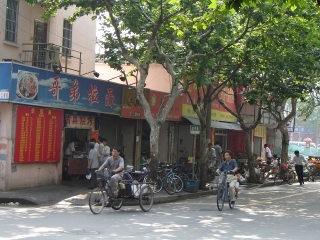 GuoShun Road, Yangpu District, Shanghai
GuoShun Road, Yangpu District, Shanghai
So, we strolled over there and
had two different kinds of dumplings for breakfast. It was
my first real encounter with the heat and humidity of a
Shanghai summer, and I soon retreated to the air-conditioned
guest house. I will adapt. I must adapt.
Later we took the 55 bus down to the Bund. In some ways this is
the epicenter of Shanghai: it's the line of colonial buildings
facing east on the embankment of the Huangpu River, which meanders
north before feeding into the mighty Yangtze. On the other side
of the Huangpu is
Pudong,
the new part of Shanghai, dominated by
ultramodern skyscrapers like something out of a bad science fiction
story. They're fun, actually — but I forgot to bring my camera.
Then we cut west on Fuzhou Road; this is
the road with all the cool book stores. We soon wound
up at People's Park, the biggest park downtown: it's the green
blob at left on the above map.
We had a late lunch at a chain called
Uncle's Cool Noodles in the basement of a big modern shopping
center — Raffles Center or something. In case you're wondering,
"Cool Noodles" means quite literally what it says.
In a steamy hot town like this one can see why this style of
noodles would become popular, but it seems to have originated
in Korea.
Then we headed south and blundered our way across Ren Min Road
into the old city — a ellipse-shaped patch of town vaguely similar
to the hutongs
of Beijing. As with the hutongs of Beijing, the old town
in Shanghai is rapidly being eroded by the incursions of
modernization. The wall of the old city has been broken
down since Lisa last visited in 2001. The famous old mosque
seems to be gone. Building projects have taken over many blocks,
enormous cranes looming overhead. But there are still lots of
twisty old streets, which I will explore more
thoroughly later — and photograph before they disappear!
Mind you, many homes in the old city look like fetid dungeons -
nothing romantic about them. One can see why the government wants
to do away with them, even if they're laden with history going
back to the Ching dynasty. As a Chinese proverb has it:
the old must go so the new can come. But I feel
nostalgia and sadness for the waning of the old city. Lisa said
she wanted to cry.
We then wandered to Yu Yuan Shangcheng, a famous garden
at the north end of the old city. It was closed but we caught
some tantalizing peeks, and had a nice stroll on the
elaborate bridge over a nearby pond, where swarms of hawkers
tried to sell me "Lolex" watches. For some
reason they assume that every Western male is yearning for
a fake Rolex timepiece.
In case your eyes are glazing
over at this recital, be assured that all the points mentioned
on today's journey are famous "must-see" sights, with
the exception of Raffles Center and Uncle's Cool Noodles.
If you go to Shanghai, you should see these things.
And
then you'll see that my descriptions are dry
summaries of the full experience, leaving out 99% of
the interesting stuff: elegant women with hair dyed auburn
talking on their cell phones as they bike past, guys pedalling
carts stacked with shockingly large amounts of various goods...
 GuoDing Road, Yangpu District, Shanghai
GuoDing Road, Yangpu District, Shanghai
...tantalizing little alleys poking off the main streets, swarms of annoying
motorbikes honking like maniacs as they run you down, zillions
of hole-in-the-wall shops selling every imaginable thing and
lots of unimaginable ones too, bare-chested men lounging
and chatting in wicker chairs by storefronts, a bucket of sad frogs on
the sidewalk, a heron patiently stalking unwary carp —
and a beggar girl with a blemished face thrusting her
arm at me, no hand on it, crying "Money! Thank you!"
And much, much more.
If I hadn't spent the summer of 2003 in Hong Kong and last
summer wandering through Beijing, Chengdu and Shenzhen, I would
have found this day utterly exhausting, just from information
overload. But I've gotten a bit more familiar
with it all, so it wasn't so tiring.
July 6, 2006
Today we left the guest house and moved into the apartment
Lisa had rented with the help of Shue Hua. Our address is
GuoQuan Ho Lu, 25 nong, 7 hao lou, 203 shi. In other words:
25 GuoQuan Back Road, 7th building, apartment 203.
The place is nothing much to look at on the outside:
But it's quite nice inside, at least
for my simple tastes: newly repainted walls, wooden floors,
a big long bedroom with a kind of study alcove at one end,
another small bedroom with a desk, a small living room,
kitchen and bathroom. Two wall-mounted air conditioners to
fend off the heat and humidity — it's blissfully cool in here!
A Chinese grad student of our acquaintance now visiting his folks in Shanghai
later described our place as "endurable", which sort of miffed
me — we're very happy with it. Sure, we could afford something
fancier, but why?
For fans of economics I should record
that this place costs Y2400 a month, where "Y" stands for
"yuan" or "renminbi". Since there are about 8
yuan per US dollar, this is $300 per month — deliciously
inexpensive for someone on my salary. To set this in context,
a Chinese peasant who comes into the city to work as a laborer
or sell things on the street makes about Y10,000 per year.
A peasant family who stays on their farm also makes about
Y10,000 per year — but divided among 5 people or so!
That's about $250 per person per year. So, our nice cheap
apartment would be utterly beyond their means.
I heard that to actually buy an apartment like ours would cost
about a million yuan, which is about 30 years salary for some
professionals. That makes their yearly salary about Y30,000 or
$4,000.
It was a day of intense logistics, which would have been
impossible without generous help from Shue Hua,
his grad student assistant Li Lin, and
our landlord, Mr. Wong. First we registered with the
neighborhood committee, which required xeroxing our passports
and visas, getting my picture taken,
and filling out lots of paperwork. Then we registered
with the local police department. Then we went to China
Telecom to get phone service and broadband internet, which
I am now happily using to post this. Then we went shopping for
essentials like bed linens, pillows, towels, laundry detergent,
a wok, and many other things I now mercifully forget. Most of
these were easily obtained in a big department store.
We ordered a desk from Fudan University, which sells them
along with lab equipment and other stuff. I think it cost
Y280. Finally, we moved all our suitcases from the guest house to
the apartment. Lots of taxi rides were required for all this —
taxis are ubiquitous here, as in most Chinese cities.
It's a great relief to be ensconced in my new abode.
July 7, 2006
The desk was delivered first thing in the morning! We went
out for jian bing,
or "Shandong pancakes", made by a friendly guy in a little
hole-in-the-wall shop. First he starts a thin crepe-like layer
of batter frying on a hot circular metal plate.
After five seconds, he cracks an egg and
smears it all over the batter. Then he dumps on scallions, pickled
ginger, and cilantro. When it's cooked, he scrapes it off,
folds it in half, and spoons on some hoisin sauce and a dab of hot
chili paste if you want — we do! Atop this he sets two pieces of crunchy
breadlike stuff. Then he folds the whole thing into a handy sandwich
and pops it into a plastic bag. A nourishing breakfast cooked
in one minute — especially tasty when you ask him to put in peanuts!
I was going to take photos of how
these are made, but I see
someone already has.
We spent the day getting our apartment set up and talking to people.
At 5 we hiked over to a big department store called E-Mart on the
corner of Quyang and Zhongshan to buy coat-hangers, a chopping
board, cups, bowls, plates, chopsticks, an electric tea-kettle, and more.
Before actually buying this stuff, we had dinner at a Xinjiang
restaurant called A Fan Ti Gourmet City across the way, on 775 Quyang.
Xinjiang
is China's largest province in area, but it's desert
land out in the northwest, only 19 million inhabitants,
mainly Uygurs. The food we ate resembled the Arabic food I know —
wonderful lamb shiskebab, flat bread and fresh dates. There
were belly dancers and loud music, but nobody paid them much
attention.
As always, I'm shocked by the low prices. Completely
serviceable and esthetically inoffensive mugs cost Y2.9 each at
E-mart — that's about 35 cents! The whole shopping trip cost about
Y220, or $26. Our dinner was about $8 for two. I'll stop talking
about prices soon, but one has to factor this in when trying
to understand life here.
July 8, 2006
Today we got wireless broadband installed in the apartment,
apparently clocking in at 7.8 megabaud. We still need a router
so we can both work online simultaneously — key to a successful
relationship. We also got some music going by hooking Lisa's
DVD player to the TV that came with the apartment. The TV has
good speakers, so it was a delight to listen to Bach's
violin sonatas played by Perlman. Music makes the world go round.
There were intermittent heavy rains today: turns out a typhoon is passing
by, heading for North Korea, doubtless to punish it for firing
missiles into the Sea of Japan. We got caught in a downpour on the
way to dinner with Shue Hua and Li Lin, who is leaving
Shanghai tomorrow. In the fall he plans to begin graduate school
in electrical engineering at UCR.
July 9, 2006
Lisa is down with a bad cold, so I spent the day catching up on
email and writing this diary. Towards the end of the day she got
up enough energy to go out and have dinner at a Szechuanese restaurant
on the little pedestrian street near where we live.
July 10, 2006
Another lazy day at home. I polished up a paper I wrote with Alejandro
Perez on the quantization of
strings and branes coupled
to BF theory and emailed it to him so he could submit it to
ATMP.
In the afternoon,
Lisa and I went out for lunch at the pedestrian street and bought
some stuff at the wet market. In China, a "wet market"
is one that sells produce.
The one here has dry goods too — and spices,
tea, fish and live chickens!
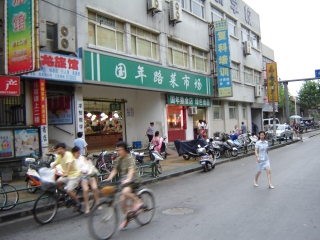 Wet market on ZhengSu Road, Yangpu District, Shanghai — outside
Wet market on ZhengSu Road, Yangpu District, Shanghai — outside
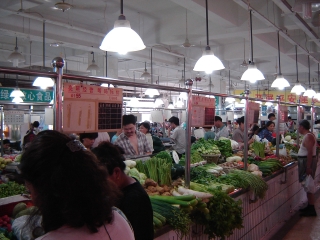 Wet market — inside
Wet market — inside
July 11, 2006
We got a wireless router! Now we don't have to take turns using
the internet. As long as I want, I can work in the little bedroom
at the front of the apartment, connected to the web, listening
to music on my headphones:
It's just like home.
But when I get bored, I can step out into Shanghai!
July 12, 2006
Lisa and I took the 55 bus down to the Bund, the old colonial
embankment on the west of the Huangpu River. If you look across the road
you can see Pudong, the newly developed area
across the river. Not too long ago it was rice paddies.
Now it looks like this:
Across the road, on the river's shore, there's a strip of park
where people come to eat, have fun, and marvel at the view:
Then we hiked west along Nanjing Road, one of the liveliest
shopping streets in Shanghai. Since it was rush hour, each
red light held back a phalanx of bicycles and scooters eager
to charge forwards when it turned green:
The prospect of crossing the road was enough to make
the newcomer hesitate before plunging in:
As we entered the heart of the shopping district, the
colorful signs became phantasmagoric:
The Shanghainese have made colored lights into quite an art;
they'll coat entire buildings with ever-changing displays:
As it got dark, we headed into the subway station...
... and went down to the French Concession, an area first leased from the
Chinese in 1846, which is now full elegant shops and funky art galleries
and cafes. On the door of one there was a poster showing an angry guy
and the words Fuckin' Politics!
This is the most "edgy"
thing I've ever seen in China — they usually try to keep things pretty
bland and sweet.
We eventually found a nice restaurant called Old
Shanghai and had a mango salad and beautifully cooked starter
of pumpkin and lily, followed by stir-fried shredded eel on rice
and a roast pigeon with pepper salt, with a bottle of rice wine.
Yum! It cost Y76, or about $9 for the both of us.
Finally we returned to the Bund to catch the bus home. The
old buildings of the Bund were all lit up:
and across the river, the towers of Pudong were gleaming:
While New York rebuilds its World Trade Center
as a
less flashy, bomb-shielded
memorial to the death of its old self,
Shanghai is soaring
to the skies in a flamboyant, wildly optimistic style. It's symbolic
of how China is cleverly sitting out the war on terror -
while the US overreaches itself and becomes entangled in wars with
Afghanistan and Iraq and showdowns with Iran and North Korea,
China has been nailing down oil deals, plunging forwards
economically, and building its military.
It's hard to help pondering
this here in Shanghai, thanks to the recent meeting of the
Shanghai Cooperation Organization,
a group consisting of China, Russia, the Kyrgyz Republic, Tajikistan and
Uzbekistan — which Iran, Pakistan and India are also eager to join. In their
meeting this June,
Putin of Russia and Ahmandinejad of Iran proposed the formation of an
energy club as part of this organization. Needless to say,
given the coming energy crunch,
some folks in the West are worried.
Note the sentence on "Chinese efforts" below:
An OPEC With Nukes?
The Shanghai Cooperation Organization
may join some of the world's leading energy and military powers
Richard Weitz
The Weekly Standard,
July 12, 2006
The recent summit of the Shanghai Cooperation Organization--a group consisting of China, Russia, and four Central Asian countries--has evoked alarm about a potent anti-American bloc emerging in the heart of Eurasia. The presence in Shanghai of fiery Iranian president Mahmoud Ahmadinejad, and the prospects for exclusive ties among some of the world's leading energy and military powers, has generated fears about a renewed Cold War between a democratic West and an authoritarian East. But these concerns are, at present, exaggerated.
The SCO lacks the internal cohesion and capabilities of strong multilateral security institutions like NATO. Its members disagree over the desirability of a Western military presence in Central Asia. They also differ over the SCO's role in traditional defense matters and whether member governments should collectively suppress domestic unrest. Furthermore, granting full membership to Iran,
Pakistan, or other SCO observers could just as easily weaken the organization as strengthen it.
The SCO has a strikingly broad agenda. Cooperation against terrorism--broadly defined to include "separatists" and "extremists"--has become a core activity, with members conducting increasingly large joint "anti-terrorist" exercises. Other initiatives encompass combating organized crime, managing natural disasters, and promoting economic and energy collaboration.
Not surprisingly, many of the SCO's weaknesses stem from this expansive agenda and diverse membership. Agreements adopted under its auspices often consist
primarily of bilateral deals, with the organization merely providing a convenient negotiating venue. While some current and aspiring members seem most interested in the SCO's economic potential, others mainly value its regional security role. Also, serious rivalries
and disputes exist among its Central Asian members--especially between Uzbekistan and Kazakhstan, perennial competitors for regional primacy.
Russia has repeatedly opposed Chinese efforts to establish a SCO free-trade zone, acquire control over Eurasian energy resources, or give the body a military dimension. As a result, the SCO remains primarily a security organization, focused on countering transnational threats from non-state actors, rather than implementing a collective defense structure like NATO. The SCO does not have its own military forces, an integrated command structure, or even a combined planning staff. Russia favors the status quo because it can veto SCO actions. Conversely, China lacks equivalent influence over the decisions of the Collective Security Treaty Organization, a genuine multinational military alliance that includes all SCO members except China and Uzbekistan.
Member governments also diverge regarding whether the SCO should protect one another against further "colored" revolutions. They accept that the organization should defend incumbent regimes against terrorist threats, which they characterize as foreign-inspired, but remain divided over whether to respond collectively to major but nonviolent domestic challenges. During the March 2005 government crisis in
Kyrgyzstan, SCO members could not agree on joint action, with military intervention reportedly favored by China and opposed by Russia.
July 14, 2006
By the way, in case it's not obvious, I'm not pushing some sort of
"yellow peril" alarmism. I just think that as China continues
to grow and the United States continues to overextend itself and sink
into debt, we'll see a shift in the balance of power. With any luck, this
will be a peaceful transition.
Lisa and I had a dinner with some of the people at Fudan University
who invited her here, including
Lu
Gusun, a Shakespearian
scholar who's the editor-in-chief of a famous English-Chinese dictionary.
We had many dishes, including sparrows — a first for me.
Most Chinese are unabashedly carnivorous and don't seem to feel
the pangs of guilt Westerners feel when eating unusual animals that
seem more "cute" than the ones we're used to eating.
While I feel these pangs myself, I don't pay them much heed unless
I think the species as a whole is being endangered by overhunting,
as with, say, sharks.
If an animal is being bred for food, I figure this is just a form of
commensalism, good for everyone in the long run — except insofar as
eating that animal wastes resources, overbreeding threatens its genome,
or it's being killed in an excessively cruel way. Maybe if I thought
about these often enough I'd become a vegetarian. Apparently
a kilogram of beef requires about
100,000 liters of water to produce...
sort of obscenely wasteful.
July 15, 2006
More unabashed
carnivory.
Our landlord, Mr. Wong, makes his living selling wines to restaurants
across China. In October, when hairy crabs migrate from
Yangcheng
Lake to the Yangtze
River to mate,
he joins hoards of tourists and rents a place near the lake
where local fishermen harvest these crabs. The tourists are
there for the crabs: over five hundred restaurants line the lake,
he said, and most are only open in October and November. He goes
there to sell wine to these restaurants. So, he's near the top
of the food chain! I leave on September 20th, but he said we
might go there — if we pay for the crabs, he'll get the wine, and
he can drive there in a company car.
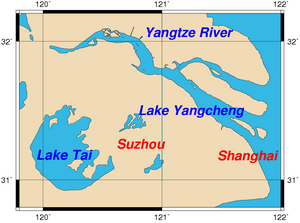
I'd like to visit Suzhou,
too. This is the city with the best
classical gardens in China. Once it had over 200 gardens, and
69 are still in good shape today. Lisa visited a number of
them, including the
Humble Administrator's Garden — it's not really
very humble! It dates back to the early 1500's (the Ming dynasty).
Another great city near Shanghai is Hangzhou,
the capital of China during the Southern Sung
dynasty, now famous for the beautiful West Lake. We were going to visit there
next week, but that plan fell through. We may go later.
July 16, 2006
A cool and breezy day after a night of rain.
Lisa and I took the 55 bus down to the Bund and strolled
down Renmin Road to the most fascinating part of Shanghai:
the old
city, Nánshì.
It's a fractal maze of twisty streets, tiny homes and streetside
shops, thick with people doing
every imaginable thing, living their lives on their doorsteps.
Cooking, chatting, sleeping, selling, playing Chinese chess,....
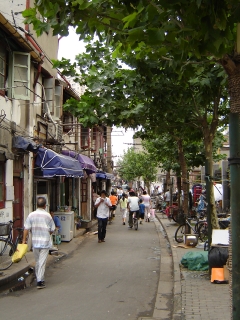 JiuCang Street a bit south of Fuyou Road, Nánshì
JiuCang Street a bit south of Fuyou Road, Nánshì
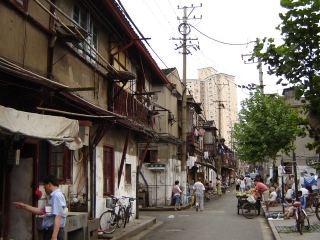 A bit further south on JiuCang Street
A bit further south on JiuCang Street
I could have taken more interesting pictures, but I didn't
want to be too intrusive. We didn't go too far in, since
we wanted to head west to the French Concession. But first
we wanted a snack at the Shanghai Classic Restaurant.
So, we doubled back and headed east on Fuyou Road
across Henan Road.
This intersection is particularly bleak: new construction
is tearing up the old city, leaving the worst
of both worlds for now:
 Henan Road just south of Fuyou Road, Nánshì
Henan Road just south of Fuyou Road, Nánshì
Lisa and I had looked for a famous
old mosque a bit south of here on our July 5th
wanderings, and failed to find it. We were quite sad, thinking it
had been destroyed to make way for a fancy hotel. So, we were delighted
when we found it on Fuyou Road just east of Henan! Our map had
been mistaken. It dates back to 1868:
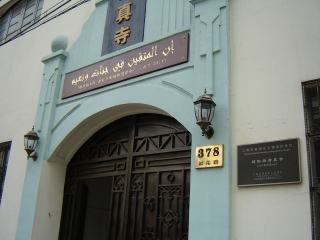 Fuyou Lu Mosque, 378 Fuyou Road, Nánshì
Fuyou Lu Mosque, 378 Fuyou Road, Nánshì
We had a wonderful late lunch at the Shanghai Classic Restaurant:
lotus, nicely cooked Ningbo style bok choy, Guangzhou style roast
goose, and crab with rice cake. The real name of this place is
Shànghǎi Lǎo Fàndiàn. The adjective
actually lǎo means something closer to "venerable" —
it shows up in the name of the philosopher Lǎo Tze.
There's a plaque on the restaurant with this story:
The Memorial for the Rebuilding of Shanghai Old Restaurant
According to the Chinese folklore, Emperor Qianlong concealed his
identity and toured around Shanghai County in 1737. By chance he took
dinner in one local bodega beside the County Temple. Satisfied
with the delicious dishes, Emperor Qianlong left his autograph,
denominating the bodega with "Longsheng Restaurant". In 1875,
Mr. & Mrs. Zhang from Pudong opened a restaurant on the same site
of the bodega and named it with "Rongshun Restaurant". They
created a new cooking style — Shanghai Cuisine, which kept up the
prosperity of the restaurant heretofore. Modern Shanghai citizens
address it respectfully by the name of "Shanghai Old Restaurant".
Then we headed west... but before
reaching the French Concession, we ran into a Taoist temple
near the old west gate of the city:
the Báiyún Guàn, or
White Cloud Temple.
Apparently it dates back to
1882.
Lisa says it's one of the two places that still hold a large portion of
the roughly 1500-volume
Taoist Canon.
Someday we'll go inside.
Anyway, it has a nice park on one side:
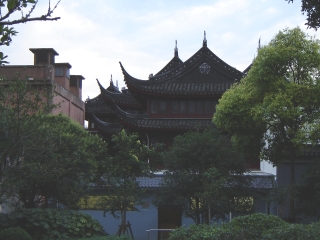 Báiyún Guàn (White Cloud Temple), Daijing Road,
Nánshì
Báiyún Guàn (White Cloud Temple), Daijing Road,
Nánshì
a high-rise behind the other:
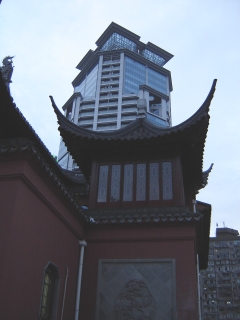 Báiyún Guàn (White Cloud Temple), Daijing Road,
Nánshì
Báiyún Guàn (White Cloud Temple), Daijing Road,
Nánshì
and some old buildings, half-demolished but still very much in use,
across the street:
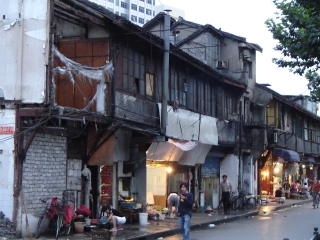 Daijing Road, Nánshì
Daijing Road, Nánshì
We then wandered to the French Concession, but only made it to the
highly modern, Westernized part with fancy boutiques and wine bars...
not my kind of thing, and certainly not worth crossing the globe for!
A lot of Western tourists seem to disagree.
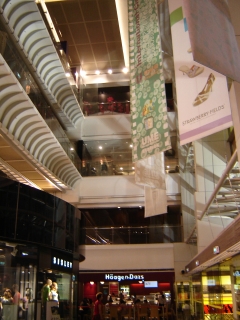 Mall on Huáihǎi Zhōng Road, Jìng Án District
(French Concession)
Mall on Huáihǎi Zhōng Road, Jìng Án District
(French Concession)
Today I've put in the accents indicating tones in pinyin, but
I don't think I'll have the energy for that most days!
July 17, 2006
This morning I was listening to the National Public Radio news on my
computer — a day late, as usual, which is no fair because our day
starts earlier. Anyway, I caught a story about
the
fast pace of economic growth in China.
Big coastal cities like Shanghai are doing well, while
poorer inland towns are not.
It's hot today.
We had a late breakfast at our favorite restaurant on GuoDing Road:
xiaolong bao, da huntun and zhou.
These are words worth knowing,
so I'll explain! "Bao" refers to a wide variety of
"buns" ranging from truly bun-like rice buns stuffed
with vegetables or pork, to more dumpling-like things.
Xiaolong
bao are dumplings
stuffed with pork and hot broth! Bite into one prematurely
and scalding fluid gushes forth, scalding your tongue. Wait
a bit, dip it in vinegar, nip into it
more cautiously, and you can carefully suck out the soup, which
is really very tasty — then eat the dumpling.
Da huntun, or literally "big wontons" — the word
"wonton" is Cantonese — are pork and vegetable
dumplings in soup, and
this particular place does them great. Zhou is
congee,
or rice porridge -
usually served with other seasonings, from pickled vegetable to meat
to fish. If you
don't like porridge, congee probably won't change your mind.
But, with the right seasonings, it can be quite nice. I've also
seen versions that are just a thin bland gruel — not nice.
July 21, 2006
Do you want to climb an active volcano?
On May 18th, 1980,
Mount St. Helens blew its top in a truly amazing
eruption. A magnitude 5.1 earthquake caused the largest
landslide in recorded history.
2.8 cubic kilometers of rock collapsed
and a blast of pressurized gas shot out, destroying
400 square kilometers of forest:
In 2004, after years of inactivity,
a series of small earthquakes heralded a
new phase in which
Mount St. Helens began shooting off steam and ash, as shown in the
top picture above. This is not considered to be the prelude to a new
big eruption; on the contrary, experts believe that this release of
pressure makes the volcano safer.
So, today the US Forest service began letting people climb to the crater
rim! You need to get a permit. Hazards may include ashfall,
ballistic rocks, volcanic gases and debris flows. If you
encounter these, don't panic. It's all just part of the show.
I've always been fascinated by volcanic and geothermal phenomena
ever since I was kid. I remember learning with pleasure about
fumaroles and solfataras. So,
I can't resist mentioning that the 1980 eruption of Mount St. Helens
caused "pyroclastic flows" and "lahars".
A
pyroclastic flow is a very
dangerous thing: a
mixture of hot gas, ash, small rocks and boulders rolling
along the ground, which destroys everything in its path.
In the eruption of Mount St. Helens, the initial pyroclastic
surge accelerated to almost 500 kilometers per hour, but slowed
as it moved further, so several people were able to escape it by
driving 100 to 160 km/hour.
(That's 65-100 miles per hour for
us Americans — normal speeds on the Los Angeles freeways when
there isn't a traffic jam.)
A lahar is a rush of water caused by an
erupting volcano. This is an Indonesian word; the very fact that
they have a word for this should be enough to depress the real
estate market there.
Sometimes lahars are caused when lava rapidly melts ice or snow;
more often they happen when heavy rains cause mudslides during
or after an eruption. You can read an impressive eyewitness account
of a lahar in Guatemala, complete with photos, at the US
Geological Survey website on volcanic hazards:
The lahar passed below us at what seemed an incredible speed
and with an overwhelming roar. The front of the flow was approximately
5 m high and filled the river channel. As the hot lahar became larger,
small rocks and mud splatter were thrown onto and over the bridge.
We decided that we were not high enough and ran for the safety of the
far bank. There, ground vibrations made it difficult to stand and we
had to shout to be heard over the roar.
A lazy morning. Detailed
street maps of the Fudan area are hard to find, especially
in English, so Lisa added street names in English to a
local area map while I pondered
Mount St. Helens, did a little work on my website and burnt her
a CD of Dylan tunes. A couple days ago we found a great CD and
movie store called Artbook Rockmusic Artmovie
on Guoding Road near its intersection with Zhengxiu. I bought copies of
"Sergeant Pepper's Lonely Heart's Club Band" and
"best of" albums by Japan and U2 for Y12 (about $1.50)
each. Apparently not bootlegged — part of some official-looking Chinese
series of rock CDs! Lisa found an incredible selection of rare
movies in the back room, and bought
two we'd never heard of: Orfeu, and an Orson Welles
movie called Mr. Arkadin.
Last night we saw Orfeu: an updating of the classic
Black
Orpheus, featuring music and even a cameo appearance
by favorite Brazilian musician, Caetano Veloso.
It was good — but very, very sad. The slums of Rio de Janeiro are
darker than in Black Orpheus —
drug gangs
rule, and the
police shoot
as many innocents as criminals.
In this retelling of
the Orpheus
myth, Orfeu and Eurídice are killed almost accidentally
by jealous friends
who instantly regret what they do — snuffing out two
of the brightest lives in the favelas.
July 23, 2006
Breakfast at a little hole-in-the wall place on the corner of
Zhengsu and Guodian. They make the best
xiaolong bao we've had, and that's
all they make, besides soup. You can get a small
bamboo steamer of about eight xialong bao for Y3 (approximately 36 cents).
You can get them to go in a plastic bag, or eat them in a
tiny air-conditioned room which is nice when it's hot out.
Calling this room a restaurant would be a gross exaggeration; it has
stools for three people, a little booth with chopsticks, some bottles of
vinegar and some hot sauce — and they're usually busy
making xiaolong bao there. But, this is nice if you want to learn how
they manage to get broth inside a dumpling! (The trick: the broth
is a cold gelatinous aspic when they put it in.)
It's the smallest, least charismatic place I've ever eaten: the floor is
dirty and the entrance is hung with clear plastic strips. But, the food
is great and the woman who runs it is very friendly — the place has a
good vibe. So, I love it.
It rained a lot last night and today it was a bit drizzly and
really cool! About 26 Celsius (79 F) — the coldest it's
ever been here during my visit. Bliss!
Back home in Riverside it's really hot.
The temperature hit 45 Celsius (113 F) yesterday,
and 41 Celsius (106 F) today. There's been an unprecendented
heat wave throughout California,
triggering lots of fires. I'm worried about my garden. Indeed,
it's been hot all over the US and Europe. Meanwhile, in
Congress, Republicans are holding a hearing to poke holes in a
famous study that led people to notice global warming, ignoring
the many studies that subsequently confirmed it.
July 24, 2006
Lisa and I wandered extensively through the Old City south of Fangbang
Road, even crossing south of Fuxing Road to see the Peach Blossom Mosque.
I took lots of pictures, mainly to preserve some record of this
unique area, which is bound to disappear soon. You can see a
bunch of them in a not very organized form.
The photos of street signs are to help me remember where everything was.
July 28, 2006
We went to a park on Huaihai Road in the French Concession.
It was very peaceful and civilized, full of people playing cards:
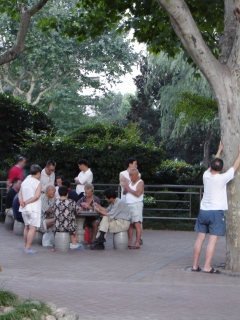
The "tree-hugger" at right is doing some idiosyncratic form of
exercise, but that's quite common in China — in any green space, especially
in the morning, you'll see people doing tai chi and qi gong, walking around
in funny ways, and even dancing in organized groups. A lot of parks
have exercise machines, too. All these forms of exercise are most
popular among the middle-aged and elderly. Now and then one sees a
younger person jogging.
From the park we could see the domes of what was once a Russian
Orthodox church, built in the 1930s — the time of Stalin's purges!
There must be an interesting story behind that.
Stalin was a Orthodox monk himself before he became a communist.
Now this church is a restaurant called
The
Grape. The inside is nothing
special, nor was the food — I don't recommend it.
July 31, 2006
Friends back in Riverside report my garden is in serious trouble
from the heat; I tell them to double the watering times on the
automatic sprinkler system. The plants may look dead now but
I've noticed that lots of our plants can bounce back when times
improve. We'll see.
Today a math grad student from UC Berkeley
named David Farris,
working at Fudan University this summer, found out I was lurking
nearby and came by to bring me a campus map and chat a bit.
Nice guy. He told me where to buy cheap math books — knockoffs
of Springer graduate texts and the like.
He also told me
that astronomers from South India invented many of the basic ideas
of calculus long before Newton and Leibniz! They were based in
Kerala.
According to Sarada Rajeev's course syllabus,
They knew of the theory of infinite series, notions of convergence,
differentiation, and iterative methods for solution of non-linear equations.
This school, founded by Madhava of Sangamagrama and included as its
prominent members Neelakanta Somayaji,
Parameswara, Jyeshtadeva and Achyuta
Panikkar, flourished between the 13th and 16th centuries — but has its
intellectual roots with Aryabhatta who lived in the 5th century.
We will review their knowledge of (pre-Keplerian, epicyclic) astronomy and the
problems that they were attempting to solve that led them to such
revolutionary mathematical discoveries. We will get a glimpse into the
contents of the first calculus textbook in the world, the
Yuktibhasha
(in the South Indian language Malayalam) written by
Jyeshtadeva in the
16th century. The spice economy of Kerala and its unique social structure
(centered around the temple and its Hindu religious rites) in which this
community of scholars existed will also be described.
I should learn a bit about this and mention it in This Week's Finds,
especially since last week I wrote
about Euclid's Elements.
Rajeev's syllabus has enough references to get started.
It's only in Hollywood that the explosive device can be disarmed with
three seconds left on the timer. The future always has one surprise
you didn't anticipate; if you expect to win by the skin of your teeth,
you probably won't win at all. - Eliezer Yudkowsky
© 2006 John Baez
baez@math.removethis.ucr.andthis.edu



